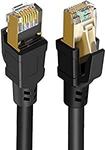Cat 8 Ethernet Cable 1.5m $11.54, 8K HDMI Cable 1m $11.89, 2m $13.29, 3m $18.19 + Del ($0 Prime/ $39+) @ CableCreation Amazon AU
Last edited 09/08/2022 - 17:13 by 2 other users
Cat 8 Ethernet Cable 5ft, LAN Patch Cord 40 Gigabit 2000MHz SFTP Internet RJ45
8K@60Hz HDMI Cable 3.3ft/1m
8K@60Hz HDMI Cable 6.6ft/2m
8K@60Hz HDMI Cable 10ft/3m
USB C to HDMI (4K 60Hz) VGA (1080P 60Hz) Adapter
 CamelCamelCamel.
CamelCamelCamel.Related Stores
closed Comments

In Australia it’s not worth upgrading from Cat5e

What if your ISP is Dodo ?

I didn't know Dodo offered an 40Gbps option. I'll have to get on it.

Based on previous experience with Dodo, I'd probably downgrade your cables

That isn't entirely true depending on your home network.
But cat8 is a complete waste in a home environment

yeah you could be doing video editing at home

@[Deactivated]: You'd need 40gbps network equipment everywhere. Which it's very rare in a home environment… Which was the posters point.

@[Deactivated]: I could google it for you, but all I was saying was that the dudes right, for 99% or more of homes 40gbps bandwidth is pointless as the gear it's plugged into won't support it…switch on one end, data cabling, Ethernet cards, etc
Could call it future proofing if you want I guess. Not too expensive.

What? That's applicable to the entire country? That's not accurate.
I run 10G at home, and while I don't need Cat8, I do need better that Cat5E

You can run 10GbE over cat5e.

not at all worth upgrading. unless you have a 40gbps ethernet card in your computer… and i daresay only very expensive servers will have them.

Depends on whether your cat5e is a proper cat5e. One of my dodgy cat5e cables was causing my el cheapo NAS to run in 100Mbits mode from time to time, I initially thought it was the NAS (because reboot tends to fix it). One day, I thought I changed the cable (mainly due to impulsive buy on cheap cat6 and cat7 cables). Switching to cat6, no such issue.
If you were like me, started using cat5e really early, then might be worthwhile checking. However, I'd probably just go MSY and get el cheapo LAN cables. Also, I am using a fake excuse of I am planning to upgrade to 10Gbps ethernet so need to start getting better LAN cables.

Cabler did mine. Have ethernet running under the house.

OOF.. that looks like it’ll break unsuspecting ports, what a beast of a cable

Does look meaty.
Zilog Z80 brings back memories. Hand written machine code. Drooling… Most young'uns no idea.

What kind of home network is setup for 40gbps.

Great hdmi cables. Recommended.

Thanks for your great support.
best of luck.

Anyone use and or recommend some easy plug and play ethernet wall plates that don't require you to cut/crimp the cable and instead just plug a cable like this into the back of the plate? Want to run a cable under house from the router to the PC.

If you cant crimp Ethernet cable I doubt you are licensed to run cables in walls. What you are doing is illegal and will void your house insurance.

I'm insured with NRMA and I've read my PDS carefully. I can't find where it says that running an Ethernet cable from one room to another will good my insurance. Perhaps it's only some insurers

Sadly in australia you need to be an electrician with a communications installer certificate to run fixed install cables.
Engaging a professional cabler
Under the Telecommunications Act 1997, only a registered cabler can install telecommunications cabling in concealed locations such as through walls, ceilings and floor cavities. You can't do it yourself.

Alright there champ

Because terrible things will happen with low-voltage milliamp current going through Ethernet cables?
Like many "you can't do that" nonsense bans, this is imposed by someone's own interest, in this case sparkie unions.

Just because the law makes zero sense, doesn't mean insurance companies won't try to use it as an excuse to deny your claim.
Never heard of it happen, but it is definitely DIY at your own risk.

terrible things will happen with low-voltage milliamp current
Sadly, they do. One of the reasons why hidden cables need to be installed by licensed people is because unlicenced people would run them wherever is easiest, often using the existing holes in woodwork where mains wiring runs. Which is fine until somebody decides to hang a picture on the wall, and drives the picture hook nail through both the mains cable and the TV antenna cable. You might not notice the picture hook is now electrically "live" whenever you turn the light switch on, but it'll kill you when you reach around the back of your TV to plug something new in.
RJ45 network plugs have slightly better insulation than TV plugs, but in reality the contacts are only slightly recessed, and still exceptionally dangerous if they're at mains potential. The wires in network cables aren't insulated to suit mains voltage either, touching the plastic of a live network cable could kill you.
People who are licensed to install cables know minimum separations between different cable types, and other rules too. Like, electricians won't install a power point or light switch close to tapwork or metal sinks.

@Russ: It won't kill in pretty much majority of situations where even that unlikely situation happens thanks to something called a safety switch. But i'm sure you know that as you sound reasonably knowledgeable already :D

@Dvbargain: Yeah you're right. I've had a couple of bites 240v over the years. Your arms retract to your chest instantly and hurts like hell. Lol

@mckayver: Haha not always though, it can cause you to clamp down on it.. But as soon as 30mA of current is missing between that active and neutral the safety switch should trip. Important thing here is having a modern switchboard

thanks to something called a safety switch.
But I'm sure that you know the requirement for an RCD on the lighting circuits came many years after the requirement to have an RCD on the power circuits, so many houses STILL don't have protected lighting circuits. And some circuits, like electric hot water and stove, are excluded from needing RCD protection.
If you believe an RCD will save you in every situation, I recommend you change your beliefs.

@Russ: I recommend you re read my above post. It clearly says majority and not "every situation".
Oven and stove are no longer precluded from an RCD by the way. All subcircuits now.

@Dvbargain: That's an interesting way of walking back your argument.
At no stage did I say "precluded". Here's the QLD government statement: https://www.electricalsafety.qld.gov.au/frequently-asked-que…
"Safety switches have been compulsory on all power point and lighting circuits for new Queensland homes built since 2000"
Stoves and hot water are not connected to power points, they are hard-wired. So your "all subcircuits" claim is wrong.
Additionally, the same statement says an RCD is not required on any circuit for any house built before 1992, until AFTER the house is sold or rented out, or when the house is rewired or is extended.
That leaves a lot of houses owned by older people, not protected and not requiring an RCD yet.

@Dvbargain: And yes you're spot on. If nothing is touched they aren't forced to put safety switches in.
Which would make home data cabling work dangerous, I agree!

In Vic it's all sub circuits now, new rules I believe
The resistive corox-type heating elements found in stoves and hot water systems are notorious for becoming electrically "leaky", which is why those circuits are excluded.
I'd be surprised if any state makes rules for those circuits, it will result in a huge number of call-outs by electricians, on an ongoing basis.
Various politicians have made similar overly-broad announcements in the past, including here in QLD, but the actual legislation covered less than the politicians had announced.

@Russ: This says ALL final sub circuits. No differentiation between hard wired or not. If I can be bothered later I'll go check my latest AS3000.
https://www.google.com/url?sa=t&source=web&rct=j&url=https:/…

@Russ: Here you go
Check out the question about whether the oven needs a safety switch https://www.neca.asn.au/vic/the%20-ten-most-frequently-asked…
@Dvbargain: That's not the actual Australian standard, that's an interpretation of them, made by an organization that wants to maximize the amount of work done by electricians.
So I wouldn't consider that as conclusive, particularly as my link was from a QLD government website. I think the QLD government website would have been fixed in the three years since the latest version of the wiring rules came out.

@Russ: Let me help you further, straight out of the AS/NZS 3000:2018 with amendments
2.6.3.2.2
… Rcds… Shall be provided for all final subcircuits in domestic and residential installations.Straight out of the rule book, lol
Edit: you're right there is an interpretation "out" in there actually. In 2.6.3.2.3.3. So you're right and I'm wrong.
ILY sorry

there is an interpretation "out" in there actually. In 2.6.3.2.3.3.
Unless I'm misreading it, from your link, 2.6.3.2.3.3 applies to commercial premises. So maybe you're right for domestic premises. I'm also not sure that being in the Australian Standard means that it automatically becomes law, it seems quite a few Australian Standards are optional.
I wish I had an easy way to access the actual Australian Standard. It sucks that we have to pay to read a document put out by our own government. I'll have to go and visit a library.

@Russ: Nah I think you're right actually mate. I have the standard in front of me. Cost me a (profanity) load.
So (profanity) that NECA says it's a requirement when it's actually just a recommendation essentially

If my house burns down, I'll just say the paperwork for the cable installation went up in flames.

At least in VIC they get lodged with the regulator :)

@Dvbargain: That also relies on the plumber/elec lodging them - now, i know they are meant to provide one to the client AND then upload it, but i KNOW that many many dont get done. Will this affect the tradie or the client more? "I've installed those two new light switches for you, ill organise a certificate and pop it in the post when i get home"…….client never receives, who is in the wrong if the house burns down?

@JuryWheel: Client isn't in the wrong but you have to do due diligence with record keeping to get yourself out of conundrums like this

Also, anyone can crimp a network cable, but it's a fiddly pain in the arse. Female to female wall plates make the job so much simpler.

punching down isn’t crimping and is easier

https://www.cablechick.com.au/cables/1x-cat6-wall-plate-rj45… or similiar, you just want female to female. or just get a punch down tool for $10-20

The cables you get to connect from your switch to your PC (i.e. these ones) are different to the ones used for wall. The ones you get for PCs tend to be more flexible, whereas the ones for the wall type tend to be tougher to bend. Also, you want to reduce using connectors after connectors. When wiring the house, you don't to use super long cables. The longer the cable, the harder it is to get good signal.

Any deals on display port cables?

Are you talking about USB C to Displayport cables or DP cable?
Or would you mind telling me the specific model of your laptop so that I can better recommend a suitable product for you?

8 out of 10 cats






I'm still on cat5e. Is it worth upgrading?